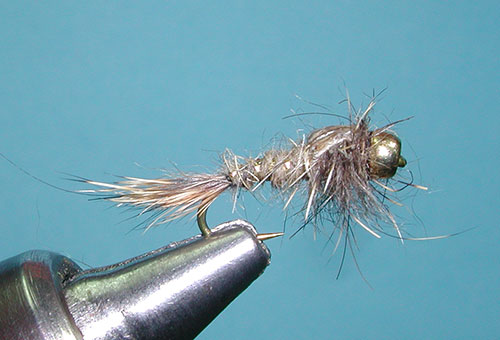

Gold-Ribbed Hares Ear Nymph  Tying Instructions |
Materials:
|
|
|
Notes: The Hare's Mask is the traditional source for the dubbing. The tail is made of guard hairs that are clipped from the area between the eyes of the mask. The underfur is removed by pinching tightly to the guard hairs, keeping them relatively even, and gently pulling away the underfur. The abdomen is made up of hares fur from the cheeks of the mask which is softer and a lighter color than other areas of the mask. This area also tends to have less unruly guard hairs. The thorax is meant to be shaggy and buggy, so I find the best fur to be located on the forehead of the mask. Often the forehead will have darker hair as well. Both the abdomen and thorax dubbing fur should be blended separately prior to tying the pattern. There are a number of commercial dubbing mixes available but often they use rabbit body fur, not Hare's mask. Some of these dubbings will also incorporate Antron, Poly, and other materials. The ribbing is often Gold Oval tinsel but, on the smaller sizes, a fine gold wire might work better. This ribbing gives the pattern it's acronym, GRHE (Gold Ribbed Hares Ear) which you'll often see posted. Use of a gold bead was a new variation when the beads became available during the 1980's. Another variation, you will often see is the use of Pheasant Tail fibers, grouse, or hackle fibers for the tail. The GRHE incorporates a wingcase of mottled Turkey but some variations will use Peacock Herl, Pheasant Tail, or Mylar. Turkey can be fragile on this pattern and you will often see an epoxy or cement finish applied upon the wingcase. Utilizing rubber legs has also been a popular varitation to the nymph. The European competition styles will often leave off the bead and leadfree wire weight so that the fly will be the light dropper on a Euro nymphing rig. Some type of hot spot or trigger, like tinsel ribbing, is preferred for these patterns. John Atherton, a prominant fly fisher in the 1930's and 40's, added a Kingfisher Blue hackle as a wingcase and this "hot spot" improved the GRHE pattern. He described the pattern in his book, "The Fly and the Fish" (1950). If the fly is greased, it floats and provides an excellent imitation of
large, hatching mayflies and caddis fly pupae. The most common method of fishing this popular fly is on a
dead drift. The nymph is cast upstream and allowed to drift within the current. This is a most effective
short-range technique and takes are usually seen as a splash at the surface. When this fly is immersed, the stiff fibers in the dubbing stand out and imitate the legs of an insect. Fish this lure below the surface with or without a small strike indicator and split-shot to help it sink. The Gold Ribbed Hare's Ear
has also proven it's effectiveness in lakes. Fished very slowly near the bed of the lake, it is particularly
attractive to brown trout. | ||
|
|